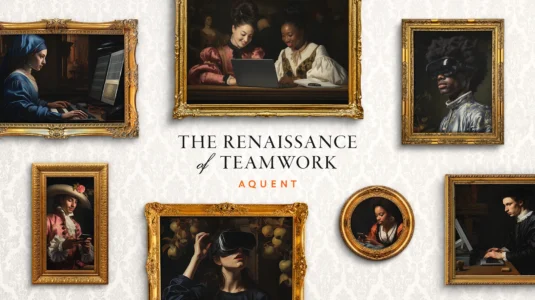

Table of Contents
Listen: Diversity recruiting strategies you need to know.
We believe the advantages of a diverse workforce are more clear than ever. In our Talent Insights Report, a survey of more than 5,000 professionals worldwide, we uncovered that one of the characteristics of high-performing teams is that they value diverse opinions and perspectives. Many companies have come to realize that diversifying their workforce is not just the right thing but also the smart thing.
This guide to building a diversity recruiting strategy is for anyone who wants to improve diversity, equity, and inclusion (DEI) in their workplace. We hope you find the strategies, tools, and tactics useful in helping you reach your DEI goals.
What is diversity recruiting?
Diversity recruiting emphasizes inclusivity, taking special care to attract and expand access to competitively qualified job seekers from underrepresented groups. In this case, an underrepresented group is a demographic category with less representation in a particular industry or workplace than the broader population.
Essentially, that's what this recruiting strategy aims to solve. To create a diverse workforce is to build an environment that reflects the general makeup of the society around it. It's a process of extending opportunities and appreciating the unique attributes each employee or qualified candidate brings to the table.
Of course, workforce diversity is inherently multidimensional. It can include race, ethnicity, gender identity, sexual orientation, ability / disability, veteran status, age, neurodiversity, and more.
What isn't diversity recruiting?
Let's clarify the use of the term “diverse.” This word is not simply a substitute for “women” or “people of color.” It encompasses a much broader spectrum of human differences. And because it describes a group, individual people should not be labeled as “diverse” or as having a “diverse background.”
A diversity recruiting strategy isn't about filling quotas. Like any hiring process, it's about hiring the most qualified candidate because of merit—not their identity. In fact, hiring solely based on protected characteristics is illegal and can lead to many negative consequences—compliance issues, reduced employee morale, reputational damage, tokenism, etc.
Instead, hire candidates based on their unique perspectives, lived experiences, and skill sets (i.e., their LEQ). This will help expand the qualified talent pool for your open roles.
Benefits of workplace diversity
Beyond being the right thing to do, why is diversity recruiting important? What's the value of incorporating diversity recruitment strategies into your hiring process?
For starters, increasing diversity enhances your business outcomes. More diverse companies are more innovative and, ultimately, more profitable. According to the World Economic Forum (WEF), businesses leading their geography and industry for diversity, equity, and inclusion are 25-36% more likely to outperform on profitability. This insight was also confirmed in our Talent Insights Report, where higher-performing teams embraced diversity more than lower-performing teams.
Other benefits of a diverse workforce include:
- Increased productivity: Diverse teams bring different viewpoints to the company, challenging standard ways of thinking and improving current processes.
- Improved creativity: The WEF reports that diverse workforces have a 20% higher innovation rate than homogenous teams. Their different worldviews also help solve problems faster, with up to 30% greater ability to spot and reduce business risks.
- Greater appeal for qualified talent: Workplace diversity can make your organization more appealing to potential candidates. Notably, 76% of job seekers and employees say DEI is an important factor when evaluating a company.
- Higher employee engagement and reduced turnover: At the same time, embracing inclusion can help retain talent, improve job satisfaction, and increase employee loyalty.
- Enriched customer experiences: With more diversity comes increased cultural awareness, which can help businesses better understand different audience needs and preferences.
What is my role in diversity recruiting?
Diversity recruitment can feel intimidating at first. Are you a team leader responsible for hiring and retaining talent? A hiring manager or talent acquisition leader who needs to use specific diversity recruiting strategies to improve how you hire? An individual employee helping your organization reach its diversity goals? Each role has an important part to play.
Team leaders and hiring managers
Team leaders may find it daunting to be responsible for not only hiring and retaining employees but also supporting DEI in the hiring process.
To recruit a diverse talent pool, you must recognize and address potential barriers. You may be ready to create a more inclusive hiring process, but your company or coworkers may not be on the same page. Sometimes, it's due to a lack of resources or company culture—but other times, it's because of unconscious bias.
Diversity Resources defines unconscious biases as “social stereotypes about certain groups of people that individuals form outside of their own conscious awareness.” They can manifest in many forms, such as preferring candidates who share similar interests or backgrounds (affinity bias), assuming certain characteristics based on age, race, or gender (stereotype bias), or the tendency to favor those who are similar to oneself (in-group bias).
Increasing diversity is everyone's responsibility. But, as a hiring manager, you play the most central role. Becoming aware of your own biases through training and self-reflection is a critical first step to mitigating their impact.
HR and talent acquisition leaders
HR and talent acquisition leaders are crucial. They're responsible for developing talent pipelines that include individuals from underrepresented groups, sourcing candidates for specific roles, and setting up best practices for hiring.
As a people leader, it's also important to understand how employees feel about the workplace. Some ways to gather these insights include:
- Engagement and exit surveys
- 90-day check-ins with new hires
- Job board websites (Glassdoor.com, Indeed, etc.)
- Salary information and transparency
- Equity audits
These techniques allow you to identify areas of improvement in your recruitment strategy. If this is your first diversity initiative, use these insights to determine if your organization is ready to embrace a more inclusive recruitment process.
Individual contributors
Increasing diversity is often thought of as a manager's responsibility. In truth, everyone has a part to play. Whether that's pointing out a biased statement or making sure you allow others an opportunity to speak, each individual can take steps to make their work environment more inclusive and welcoming.
Another way you can help? Refer candidates from underrepresented groups for open positions at your company. According to Apollo Technical, referrals account for 30-50% of all new employees in the United States, so it's an established pathway to employment.
Think about the people in your network. Do you know a candidate from an underrepresented group? Reach out and refer them for relevant roles and opportunities. The more diverse your referral stream, the more diverse your workplace can become.
Diversity recruiting strategies you can use
There are many ways to improve your diversity recruiting efforts and foster workforce diversity.
Auditing your job postings
The way you create job board listings can significantly impact the recruitment process. Conducting a thorough review will ensure your postings are inclusive and appealing to a diverse range of potential candidates.
Some factors to consider include:
- Language: Avoid jargon or culturally biased phrases that might deter diverse applicants. Instead, use neutral language that communicates your commitment to DEI. For example, statements like “We encourage applicants from diverse backgrounds to apply” can make the postings more welcoming.
- Requirements: Don't overload the job description with a long list of requirements. This can inadvertently discourage candidates if they don't meet every single criterion. Focus on must-have skills instead of nice-to-haves.
- Benefits: Consider how you describe your company culture and benefits in the job posting. Highlight work-life balance, flexibility, and employee benefits that appeal to a broad spectrum of people, like health insurance, retirement plans, parental leave, and more.
Actively targeting diverse candidates
You can't build workforce diversity if you aren't reaching out to untapped populations. One way to broaden your talent pool is by working with certain organizations, such as:
- Historically Black Colleges and Universities (HBCUs) and Hispanic Service Institutions (HSIs)
- Women in science, technology, engineering, and mathematics (STEM) groups
- Organizations focused on placing veterans in the private sector
Let them know you're looking for potential candidates to get the ball rolling. Also, encourage conversations on social media, in keynote speeches, company newsletters, and so on—and always ask for referrals.
Using AI in diversity recruitment
The adoption of AI tools offers a promising path for organizations looking to improve their diversity recruitment efforts. As explored in AI can help diversity recruiting, but ask these questions first, AI-based solutions can play a crucial role in reducing unconscious bias, simplifying the evaluation of candidates, and promoting a more inclusive hiring landscape.
By implementing AI technologies such as GapJumpers or HireVue, companies are able to anonymize resumes and objectively evaluate candidate responses, selecting top talent based on merit and thus enhancing diversity in their workforce.
However, it's vital to approach AI integration with a critical mindset, questioning the specific role AI will play in the recruitment process, examining programming practices to prevent bias, and continuously evaluating outcomes to ensure the hiring process remains equitable and effective.
A thoughtful and accountable approach to using AI in recruitment not only maximizes the technology's benefits but also emphasizes the importance of careful consideration in using these tools to support diversity and inclusion successfully.
Creating an ERG Ambassador Program
Employee resource group (ERG) Ambassador Programs can be a highly effective diversity initiative. ERGs are voluntary, employee-led groups within your organization that focus on shared identities or experiences and provide support, advocacy, allyship, and professional development opportunities to their members.
Through an Ambassador Program, potential candidates can engage with ERG representatives (i.e., ambassadors). Here, they learn about the company's culture and commitment to inclusion, which can positively impact the recruiting process.
ERGs are a great resource, but keep in mind that organizing them takes time and energy. This extra work is sometimes in addition to the time employees spend managing their day-to-day tasks.
Showcasing diversity in your brand
Job seekers need to see how your company promotes diversity, equity, and inclusion. The best way to do that is by making your commitment obvious from the start.
For example, add inclusive images to your website, career page, and social media. In other words, showcase your team's diversity and / or your desired future state. This can make potential candidates feel more comfortable about the work environment and encourage them to apply.
You should also consider digital accessibility. It's about making digital assets and tools, like your website or job board, more accessible to everyone, whether they have a disability or not. From captions on videos to alt text for images, there are many ways to make your channels more inclusive.
Using diversity recruiting tools
Many different diversity recruiting tools can help you find, connect with, and hire talent from underrepresented groups. They range from do-it-yourself (DIY) resources you can incorporate into existing hiring tools and strategies to full-service offerings that support you through the end-to-end hiring process.
Some examples include:
- Aquent Talent's Diversity Recruiting Solution
- Diversity Toolkit
- Equity audits
- HBCUs and Hispanic Serving Institutions (HSIs)
- Diversity hiring events
- ERGs
- Social media networking groups
- Specialized job boards
- Certified diversity recruiting professionals
It's important to keep in mind that there is no magic bullet diversity recruiting tool. You might consider adding a few different tools to your arsenal that make sense for your process and goals.
Mitigating unconscious bias
Unconscious bias in the hiring process can appear in many forms. Job descriptions can discourage underrepresented populations from applying. Interview processes can prevent candidates from reaching the final hiring stage. Both can unintentionally work to perpetuate bias and limit workplace diversity.
One way to mitigate unconscious bias and these pitfalls is by conducting an equity audit. In brief, it's a benchmarking tool for evaluating DEI in your organization. Audits compare the trajectory of two groups of employees (e.g., women versus men in leadership) to identify disparity and potential sources of workplace inequity. In turn, you can focus on these areas of improvement.
Here are three more ways to help ensure a fair recruitment process:
- Be aware of potential biases within your organization's infrastructure, systems, and practices.
- Standardize candidate assessments with structured interviews to ensure you can make apples-to-apples comparisons.
- Start using panel interviews instead of one-on-one discussions. Panels allow for a wider spectrum of opinions and should include members of various backgrounds.
How to retain a diverse workforce
If your organization wants to be diverse, part of your strategy must be to hire people from all backgrounds. However, another part must be to keep your best employees from leaving.
Here are a few key questions to consider:
- Do your employees feel like they can bring their whole selves to work?
- Do they feel like they have to hide their identity or assimilate to fit in?
- Do they feel included on the team and among their peers?
- Do they see people like themselves in leadership roles?
- Does everyone get fair access to internal opportunities (promotions, projects, etc.)?
- Does everyone receive mentoring and / or sponsorship?
- Are all voices heard and valued?
Answering these questions can help you uncover blind spots and imbalances. The good news? Here are some steps you can take to cultivate an inclusive culture:
Make internal hiring processes fair
Access to internal work opportunities is sometimes hard to find. Because of this, employees may have no clear path to advance their careers. Post all jobs, include clear hiring instructions, and consider all qualified applicants.
Provide the resources employees need
Ensure employees have access to the people, places, and things they need to perform their duties. Reach out and ask them if there's anything you can do to connect them to the right resources.
Offer a seat at the table
Important voices are often left out of meetings, especially when they're held behind closed doors. Rather than sending calendar invites based on a person's role, think about gathering a wide range of perspectives instead. That way, your diverse workforce is fairly represented.
Create a culture where people feel safe
Encourage employees to talk about their jobs without fear of judgment. This creates a culture of belonging and inclusion. In effect, your employees can be themselves at work. ERGs also help create a culture of psychological safety and belonging.
Consider current hiring practices before making changes
Companies are making strides in hiring more diverse groups into entry-level positions, but in many organizations, upper-level management and the C-suite are still disproportionately white and male.
Create a supportive, safe internal operation for the folks already there. To make your company's strategic decision-making process more inclusive, you should promote from within when possible and make sure that promotion decisions are not biased against underrepresented groups.
Embrace workplace diversity
When it comes to building a diverse workforce, it's never too soon or too late to get started.
If you want to craft an inclusion strategy to attract diverse and qualified candidates, connect with Aquent Talent today.
Related

Great brand collaborations are the best to strengthen identity.
Design & Experience, Insights & Trends, Marketing & Creative, Beauty and Fashion

Consumer demand and policy are driving EV market growth.
Development & Technology, Insights & Trends, Automotive

Are you missing opportunities to improve health screenings?
Design & Experience, Marketing & Creative, Health




